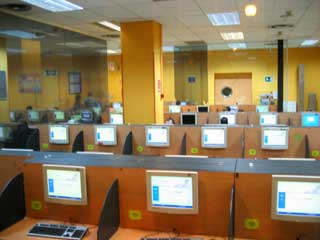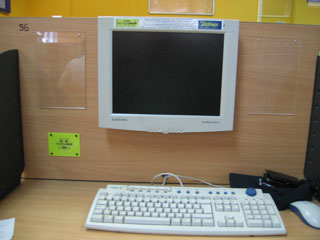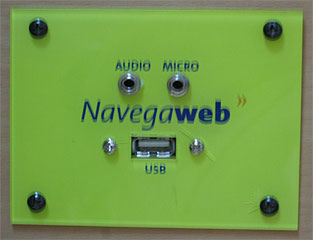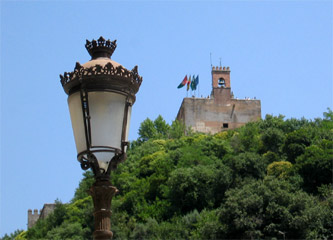
Click above image for a slightly larger view.
Without doubt, Granada, with its rich history and large surviving historical complexes, was for me the highlight of our Spanish visit. Granada has about 1/2 the population of Seville, with a population of around 250,000 people. The city is located close to the Sierra Nevada mountains, and its skyline is dominated by the Alhambra palace-fortress, that is perched on a small hill overlooking the city.
We arrived here at around 5:30pm in the afternoon, having no difficulty finding the hotel, due to some excellent maps purchased in Seville, and due to the Hotel having excellent street signs guiding us to its parking. Like many cities in Spain, Granada has a mix of wide and narrow streets, quaint fountains, and a vibrant night life.
I read that Granada began as an Iberian settlement, that was later occupied by the Romans. Muslim forces took over from the Visigoths around 700 AD, with the help of the Jewish community (who clearly must not have liked the Visigoths). Various Muslim factions controlled Granada (and resided in the Alhambra) until 1492, when Isabella and Ferdinand of Spain conquerored the city.
How Granada fell, is a fascinating story in itself, and like many events in history, it had some of its routes in a marital dispute! The Granada emir Abu Al-Hasan ran afoul of his wife Alixa, possibly because of his relationship with his harem favourite Zoraya (a Christian, from the north). Boabdil (son of Abu Al-Hasan's wife Alixa) and his mother lead a faction to dispose the emir. A civil war started in 1482, and the Christian armies (of Isabella and Ferdinand) that invaded the Granada emirate took full advantage of the civil war. The Christians captured Boabdil in 1483, and forced him to ally himself with the Christians (and in turn they helped him over throw his father). In 1485 Abu Al-Hasan died, and Boabdil gained control of the city. But the Christians pushed across the rest of the emirate (devastating the countryside) and in 1491 they lead siege to Granada. Although the "writing" (of Granada's coming defeat) was probably "on the wall", the fortifications at Granada didn't fall by direct assault. Instead Boabdil surrendred Granada in exchange for 30,000 gold coins, and a rather feeble (and unkept) Christian promise of of political and religious freedom for his subjects.
Of course religious persection (by the Christians) of both Muslims and Jews (including mass ethnic cleansing) took place over the course of the next few centuries, and Granada fell into a steady decline. It wasn't until the 19th century that a restoration of Granada's Islamic herritage (and the arrival of tourism) halted the decline.
A visit to the Alhambra was the highlight of our Granada visit, and indeed, together with the "overall" Spanish experience, the most memorable part of our visit to Spain. There is a lot of history rolled up into this majestic site, and as noted in the Lonely Planet guide, the Alhambra is the stuff "of fairy tales".
I read the Alhambra gets its name from the Arabic "al-quala'at al-hamra" (red or crimson castle). While there was purportedly a fortress on this site since the 9th century, history records that it wasn't until the 13th century that it became the home for kings. I was intrigued to learn that the first palace on this site was built by the Jewish grand vizier of one of Granada's 11th century Muslim (Zirid) sultans. It was the nasrid emirs of the 13th and 14th century who turned the Alhambra into a fortress-palace complex, adjoining a small town (Medina).
I enjoy visiting old castles, and I was not disappointed by the Alcazaba, or at least by what remains of it. Mainly there are ramparts, large walls, and several towers. There are some incredible views of the city, and I made efforts to cast my mind and imagination back 8 centuries, to get a flavour as to what the fortress must have looked like then.
Some accounts state this is the most impressive Muslim building in Europe. Despite the sweltering heat of close to 40 deg C outside, inside the Palacio Nazaries there was peace and tranquility, not achieved through airconditioning, but instead achieved by superbly designed rooms with central areas with lovely fountains and walks. The design and proportions of the rooms are purported marvels, and still have much of the original elaborate carvings, carvings, and inscriptions.
To visit the Palacio Nazaries (and its adjacent Jardines del Partal) requires that one enter at the specific time stated on their tickets. We ended up being the first group of the morning, arriving at 8:30am. Perhaps not the best time, but by lagging a bit, we did manage to see some views not too cluttered by tourists.
Purported the name "Generalife" means "Architect's Garden". I've read they were built "next to" (and adjoining) the exiting Alhambra complex, in the 14th century. For us Generalife was a peaceful mix of superbly trimmed hedges, gardens, paths and fountains, located on a secondary hillside, facing the Alhambra. Like the Alcazaba and Palacio Nazaries, in spots it shares some fabulous views of the countryside.
While a "minor" tourist attraction, in comparison to the Alhambra, the Cathedral in Granada is very impressive in its own right. Construction of the Cathedral begain in 1521, and lasted until the 18th century. It has been referred to as "cavernous" and its design shows a "Gothic/Renaissance" look.
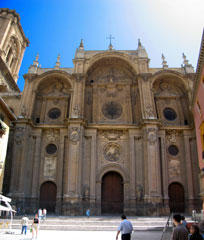
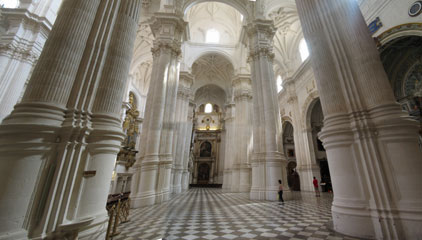
Granada has a lot of interesting architecture, with many places to visit, from the Albayzin (the old Muslim quarter), to the mirad of shops in a downtown core, to Campo del Principe area, which is close to the old jewish quarter. I've included some images below, to provide an impression of the city.
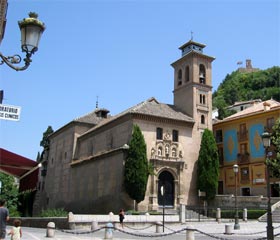
I enjoyed pausing for a rest, in a bench in the following square, and I took both daytime and night time views.
Daytime view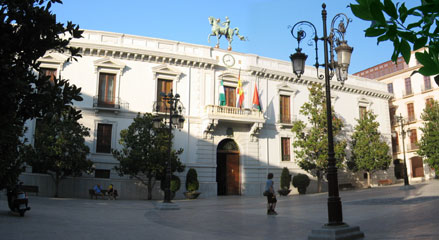
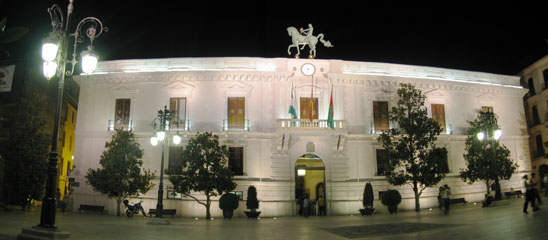
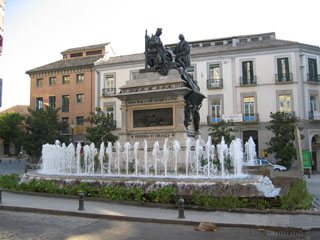
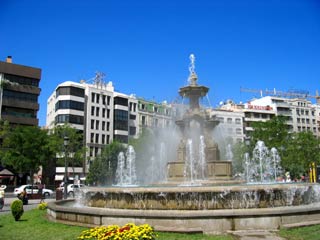
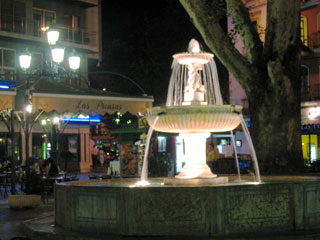
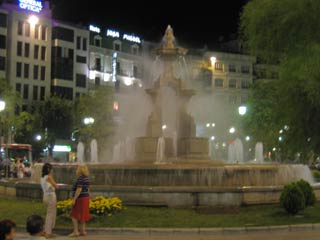
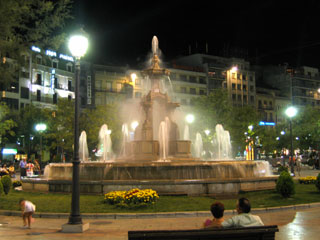
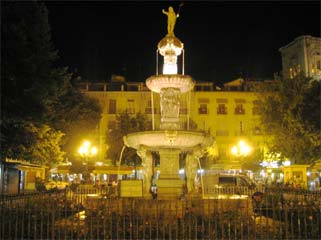
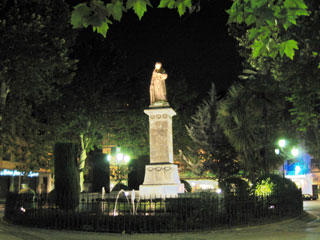
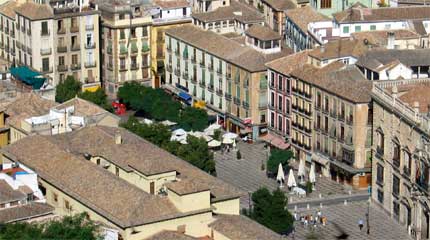
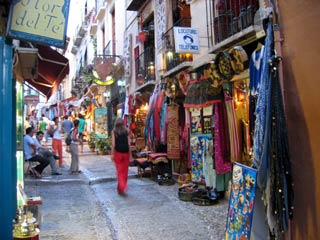
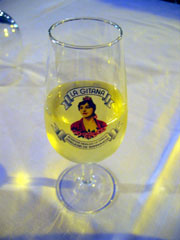
There were many bars and cafes around Plaza Nueva, on the edge of the Muslim quarter. And if one ventured more inside the quarter, there were more pubs and some discos to be found. However wandering the narrow streets of the Albayzin did not feel as safe to us as the narrow streets of Seville, nor the narrow streets of the old-Granada jewish quarter, so we did not venture too far off of the streets where there were many people.
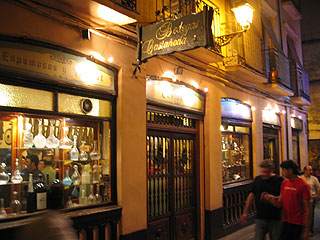
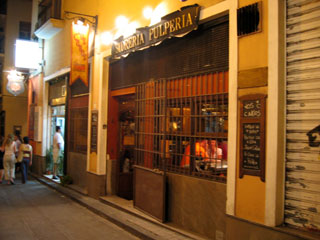
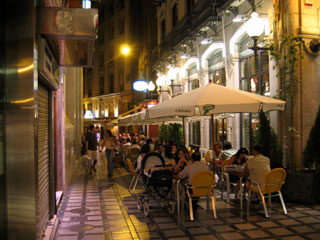
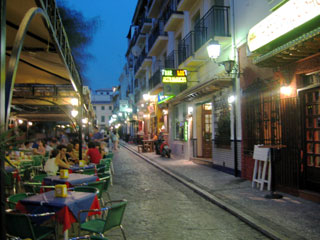
Wandering back at night, in the warm Spanish evening, we spotted many old churches, and streets, interspaced amongst old building, in the stoned narrow cobble stoned streets. There was also the occasional side walk cafe. It was a friendly and pleasant environment, as we stumbled back, in the evenings, to our hotel.
This next image shows an old and very small church, buried in some inconsequential side street. At first I thought an image was impossible, without a wide angle lens. But then I spotted a narrow crack between two buildings, and I squeezed myself in there, to get a few extra feet in a "panoramic shot". The affect of the image stitching software is quite evident in this image. Still, it is a picture that I otherwise would have had to forget.
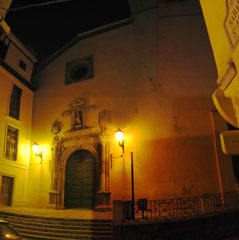
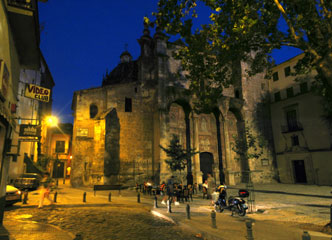
While we brought our laptop with us (and we were able to access the Internet at various Hot Spots and also via a dial-up connection) this Internet cafe caught our eye. At one-euro/hour it was very cheap, we went here to surf a few times.
